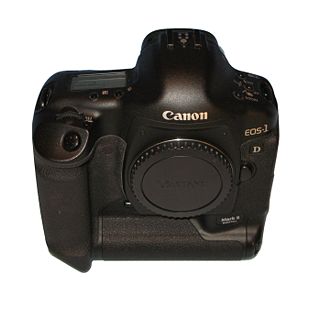Canon EOS-1D Mark II
Digital camera model From Wikipedia, the free encyclopedia
The EOS 1D Mark II is a professional 8.2 megapixel digital single lens reflex camera (DSLR) camera body produced by Canon. The EOS 1D Mark II was the successor of the EOS 1D and was itself replaced by the Canon EOS-1D Mark III in 2007. It was Canon's first dual-card slot EOS camera with one CF slot and one SD slot[3] that was meant easily to use two dominant card types and have an assurance that once a small sized primary and faster CF slot is full, camera can be used to take photographs when recording was continued on secondary and slower card in critical moment. It also now had wireless capabilities. When paired with the new Canon WFT-E1, you could transfer images to a PC using an FTP server.
This article needs additional citations for verification. (October 2011) |
 | |
| Overview | |
|---|---|
| Type | Single-lens reflex |
| Released | April 2004 |
| Lens | |
| Lens | Interchangeable (EF) |
| Sensor/medium | |
| Sensor | CMOS |
| Maximum resolution | 3,504 × 2,336 (8 million) |
| Storage media | CompactFlash (Type I or Type II) or Secure Digital / max CF:8GB SD:2GB (This can be fixed with Firmware Version 1.2.6.) |
| Viewfinder | |
| Viewfinder | Optical |
| General | |
| Made in | Japan |
| Chronology | |
| Replaced | Canon EOS-1D[1] |
| Successor | Canon EOS-1D Mark III[2] |
Features
Summarize
Perspective
The EOS 1D Mark II features:
- 28.7 × 19.1 mm CMOS sensor
- 8.2 megapixel effective (8.5 megapixel total)
- DIGIC II image processor
- Canon EF lens mount (excludes EF-S)
- 1.3x crop factor
- 45-point TTL-AREA-SIR autofocus with a dedicated CMOS sensor
- TTL full aperture metering with 21 zone SPC
- 100–1600 ISO speed equivalent (ISO can be expanded to L: 50 or H: 3200 with custom function)
- 30–1/8000 sec. shutter speed and bulb
- Auto white balance
- Eye-level pentaprism viewfinder with approx. 100% coverage
- 230,000 pixel, 2.0" color TFT liquid-crystal monitor with approx. 100% coverage (for JPEG images)
- E-TTL II flash mode
- 8.5 frames per second continuous shooting (JPEG: max. 40 frames, raw: max. 20 frames)
- Dimensions (WxHxD): 156 × 158 × 80 mm (6.1 × 6.2 × 3.1 in)
- Weight (body only): Approx. 1220 g
- Battery: Canon NP-E3 NiMH: 12v 1650mAh 300 g
- Microphone for recording voice annotations
- Shutter lag 40ms
The camera's image sensor is a CMOS-based integrated circuit. It has approximately 8.5 million total pixel sensors in a Bayer filter pattern. A non-removable anti-aliasing filter (optical low-pass filter) is located in front of the image sensor.
The shutter is an electronically controlled focal-plane shutter. Its maximum speed is 1/8000 second. Soft-touch shutter release occurs via an electromagnetic signal.
EOS-1D Mark II N

On August 22, 2005, Canon announced the successor to the EOS 1D Mark II. The new Canon EOS-1D Mark II N features the same 8.2 megapixel CMOS sensor, DIGIC II image processor and 8.5 frame per second shooting speed of its predecessor. The primary changes are a new 2.5" wide viewing angle LCD monitor, Evaluative Metering, an improved buffer, and new 'Picture Style' image parameters.
Users
- Director Tim Burton on the stop-motion animation film Corpse Bride (2005)[4]
- James Nachtwey
- Phil Martin
Gallery
- back of the camera
- battery pack
- Memory card slots for Compact Flash and Secure Digital
- Mode selectors
- Shutter release button
See also
References
External links
Wikiwand - on
Seamless Wikipedia browsing. On steroids.





